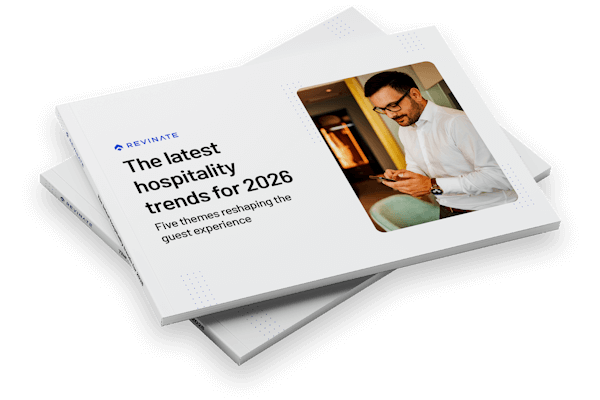AI will turn upselling from “send offers” into “solve needs”
AI will turn upselling from “send offers” into “solve needs”
This article was written by Henri Roelings.
The next wave of upselling will be smarter, quieter, more contextual, and more effective. Instead of static menus or one-off emails, AI-powered upselling will coordinate offers across channels and moments to meet the guest’s true goal: reducing friction, enhancing comfort, and creating delightful moments.
What will change in practice:
- Dynamic offer generation. AI models will assemble the personalized bundle in real time using price elasticity, live inventory, and guest context. Think “airport transfer at 07:10 with child seat and wake-up call” instead of a generic offer card.
- Propensity and value prediction. Offer timing, channel, and incentive are tuned for conversion likelihood and profit margin, not just revenue.
- Conversation as a storefront. Messaging becomes a revenue channel. AI chat agents in WhatsApp, SMS, or brand apps answer questions, then convert with relevant add-ons, checking PMS and POS data in real time.
- Continuous testing. Copy, visuals, and bundles evolve through self-running experiments designed by AI, not just manual A/B tests.
- Revenue integrity and guardrails. AI Models learn your brand voice, respect inventory limits, and protect contribution margins, ensuring automation stays on brand and budget.
Are hotels ready? A frank assessment
Most hotels are not fully ready to capture AI’s potential. Three key gaps stand out:
- Data readiness. Guest and stay data are often fragmented across PMS, CRS, POS, spa, and table reservations. Identity resolution is weak, and consent tracking is inconsistent.
- Integration maturity. Many hotel tech stacks still rely on flat-file exports or brittle point integrations. Real-time webhooks and event streams are rare outside of advanced groups.
- Operating model. Marketing, revenue, and operations often act in silos. No single owner for total guest value per stay or upsell contribution margin.
There is a leading edge of groups with strong APIs, a CDP, and clear governance. The mid-tier brands have partial foundations but need data refactoring. Independent hotels typically depend on vendor presets — but packaged AI can help them modernize and compete.
Do tech stacks need an upgrade?
Yes…but be targeted! You do not need a full rebuild, just four enablers.
- Clean, consented first-party data. A lightweight hotel CDP or data layer that unifies identity, preferences, and consents — creating the foundation for compliant personalization.
- Real-time integrations. PMS, CRS, and POS events exposed via webhooks or a message bus so AI can react to the guest’s context in real time, not yesterday’s export.
- Offer catalog with metadata. Treat every ancillary service like a product. Each item should have price rules, capacity links, blackout logic, images, and suitability tags so models can compose valid bundles.
- Experimentation and guardrails. A simple experimentation service and policy layer to ensure brand tone, compliance, and margin control.
We are still in the early innings
Generative AI and predictive models already LIFT opt-in and conversion rates, but real transformation comes when hotels operationalize data and adopt AI-driven workflows that act autonomously. 2026 will feel like the leap from manual to system-guided revenue management — and those who start now will see compounding results.
Challenges ahead for independents
The path won’t be the same for everyone. Independent hoteliers face a steeper climb than branded hotels within larger groups. Big brands benefit from centralized data platforms, standardized PMS/POS stacks, and dedicated analytics teams, which make identity resolution, real-time integrations, and controlled experimentation far easier. They also enjoy negotiating power with vendors and can amortize innovation costs across hundreds of properties, letting them iterate quickly on AI-driven offers.
Independents, by contrast, tend to run heterogeneous systems, have thinner budgets and fewer specialist roles, and lack the scale to A/B test meaningfully. They can, however, move faster on governance and process, choose modern plug-and-play vendors, and productize a smaller set of high-margin ancillaries. With a pragmatic data layer and clear owner for upsell margin, an independent can still out-execute a slower brand machine on speed, authenticity, and guest relevance.
Independent hoteliers can also lean into peer networks and regional hotel associations to close the knowledge and scale gap. Use these forums to share best practices, pool buying power for vendor contracts that include real-time integrations and experimentation, and run joint workshops on data governance, privacy, and AI guardrails.
Regional hotel associations can curate vetted vendor shortlists, provide baseline benchmarks by segment and season, and host a shared “sandbox” where members pilot upsell journeys with anonymized data and compare results. This collaborative model accelerates learning, reduces cost and risk for individual properties, and builds a local talent pool that understands both hospitality operations and AI upselling best practices.
Five recommendations
Start small. In 2026, treat AI as a readiness exercise: run a tightly scoped pilot, learn fast, and use those learnings to strengthen your (data) foundations.
- Make data usable. Stand up a lightweight guest data platform that unifies identity and consent across PMS, CRS, and messaging. Start with your top three ancillaries and the top five data events that drive them.
- Productize your ancillaries. Create a structured offer catalog with photos, tags, constraints, and margin targets. If AI can’t understand your offer logic, it cannot sell the product.
- Demand real time from vendors. Ask for webhook-ready PMS and POS connections, and inventory checks. Put this in RFPs and renewal criteria.
- Assign one owner for upsell margin. Align marketing, revenue, and ops around shared KPIs: attachment rate, take-rate by segment, contribution margin, and guest satisfaction impact. Review weekly.
- Pilot, measure, then scale. Run 90-day pilots on one segment and two channels, with holdouts and guardrails. Keep what lifts contribution margin and guest NPS, drop the rest, then expand.
When you get the basics right, AI stops being a headline and starts creating real guest value and measurable profit. The opportunity is here; your readiness will decide how much of it you capture.
This site is protected by reCAPTCHA and the Google Privacy Policy and Terms of Service apply. View our Terms & Conditions here. *Required fields.






